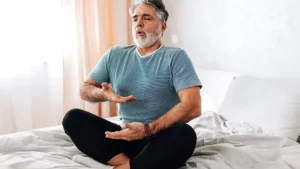
Breathe Better: Techniques That Can Save Your Life
Take a deep breath. Feels good, right?
Breathing is something we do about 20,000 times a day—yet most of us are doing it wrong. Shallow, rushed, or chest-based breathing can raise stress, reduce oxygen intake, and silently harm your health over time.
But here’s the good news: learning to breathe properly isn’t just calming—it can lower blood pressure, improve focus, reduce anxiety, and even prevent health crises. Some techniques are so powerful, they’re being used in emergency medicine, therapy, sports, and meditation.
Let’s dive into life-saving breathing techniques that top experts trust—and how you can start using them today.
Also check for : the-sleep-routine-top-doctors-swear-by
Why Your Breath Matters More Than You Think
Your breath controls more than just your lungs. It directly affects:
-
Heart rate and blood pressure
-
Brain function and emotional control
-
Stress and anxiety levels
-
Sleep quality
-
Pain perception
-
Immune response
By learning how to breathe better, you can instantly shift your body from “fight-or-flight” to “rest-and-repair”—something that can literally save your life in moments of stress or crisis.
Signs You’re Breathing Incorrectly
Many people don’t even realize they have dysfunctional breathing. Watch out for these signs:
-
Shallow chest breathing
-
Frequent yawning or sighing
-
Mouth breathing (especially at night)
-
Feeling anxious without reason
-
Poor sleep or fatigue
-
Brain fog or frequent headaches
If you experience any of these, your body may be under-oxygenated, which can strain your organs over time.
1. Box Breathing (Navy SEAL Method)
Used by Navy SEALs to stay calm in combat, this technique helps control panic, reduce anxiety, and clear the mind.
How to do it:
-
Inhale for 4 seconds
-
Hold for 4 seconds
-
Exhale for 4 seconds
-
Hold for 4 seconds
-
Repeat for 4–5 rounds
Why it works:
This method balances oxygen and CO₂ in the blood, activates the parasympathetic nervous system, and centers the mind.
2. Diaphragmatic (Belly) Breathing
This is how we were born to breathe—deeply and from the diaphragm. It’s the foundation of better breathing.
How to do it:
-
Sit or lie down comfortably
-
Place one hand on your chest, the other on your belly
-
Inhale slowly through your nose so your belly rises (not your chest)
-
Exhale slowly through pursed lips
-
Repeat for 5–10 minutes daily
Why it works:
This technique improves lung capacity, lowers stress hormones, and helps reduce blood pressure.
3. 4-7-8 Breathing (Sleep & Stress Relief)
Popularized by Dr. Andrew Weil, this breathing pattern is incredibly effective for calming nerves and falling asleep faster.
How to do it:
-
Inhale through the nose for 4 seconds
-
Hold the breath for 7 seconds
-
Exhale slowly through the mouth for 8 seconds
-
Repeat 4–8 times
Why it works:
It slows your heart rate, relaxes the nervous system, and decreases cortisol (stress hormone) levels.
4. Pursed-Lip Breathing (For Lung Health)
Often used in hospitals for patients with asthma or COPD, this technique helps regulate oxygen flow and clear the lungs.
How to do it:
-
Inhale through your nose for 2 seconds
-
Exhale slowly through pursed lips (like blowing out a candle) for 4 seconds
-
Focus on making the exhale longer than the inhale
Why it works:
It improves oxygen exchange and can help during shortness of breath or panic attacks.
5. Alternate Nostril Breathing (Nadi Shodhana)
A yogic technique known to balance brain hemispheres, improve focus, and calm the mind.
How to do it:
-
Close your right nostril with your thumb and inhale through your left
-
Close your left nostril and exhale through the right
-
Inhale through the right, then exhale through the left
-
Continue for 5–10 cycles
Why it works:
This balances energy flow, sharpens mental clarity, and supports nervous system regulation.
When Breathing Can Save Your Life (Literally)
Breath control techniques aren’t just for yoga or meditation—they’re being used in:
-
ERs to calm trauma patients
-
Military training to prevent panic under pressure
-
Therapy for anxiety, PTSD, and panic disorders
-
Athletics to improve endurance and oxygen efficiency
-
Chronic illness management to lower inflammation and heart rate
And perhaps most importantly, breathwork is now being studied as a preventive tool for heart disease, stroke, and mental health conditions.
Everyday Breathing Habits That Make a Big Difference
Here are small changes you can make today:
✅ Breathe through your nose, not your mouth
✅ Sit up straight or improve posture to let your lungs expand fully
✅ Avoid holding your breath when stressed—breathe slowly and deeply
✅ Practice at least one breathing technique daily
✅ Pay attention to your breath during exercise, sleep, and work
Final Thoughts
Breathing is the only vital function we can consciously control—and mastering it can improve every area of your life.
Whether you’re managing stress, trying to sleep better, boosting athletic performance, or just want to live longer and feel calmer, proper breathing is a free, powerful tool that’s always within your control.
It only takes a few minutes a day, but the benefits are lifelong. So, take a breath—slow, deep, and intentional. Your body and mind will thank you for it.